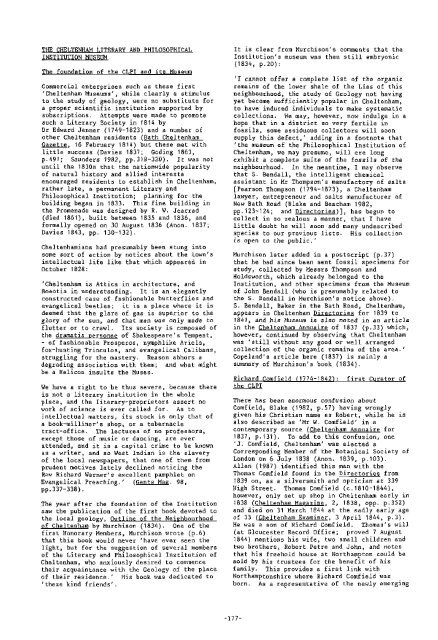Number 5 - Geological Curators Group
Number 5 - Geological Curators Group
Number 5 - Geological Curators Group
You also want an ePaper? Increase the reach of your titles
YUMPU automatically turns print PDFs into web optimized ePapers that Google loves.
THE CHELTENHAM LITERARY AND PHILOSOPHICALvCommercial enterprises such as these first'Cheltenham Museums', while clearly a stimulusto the study of geology, were no substitute fora proper scientific institution supported bysubscriptions. Attempts were made to promotesuch a Literary Society in 1814 byDr Edward Jenner (1749-1823) and a number ofother Cheltenham residents (Bath CheltenhamGazette, 16 February 1814) but these met withlittle success (Davies 1837; Goding 1863,p.491; Saunders 1982, pp.318-320). It was notuntil the 1830s that the nationwide popularityof natural history and allied interestsencouraged residents to establish in Cheltenham,rather late, a permanent Literary andPhilosophical Institution; planning far thebuilding began in 1833. This fine building inthe Promenade was designed by R. W. Jearrad(died 1861), built between 1835 and 1836, andformally opened on 30 August 1836 (Anon. 1837;Davies 1843, pp. 130-132).Cheltenhamians had presumably been stung intosome sort of action by notices about the town'sintellectual life like that which appeared inOctober 1828:'Cheltenham is Attica in architecture, andBoeotia in understanding. It is an elegantlyconstructed case of fashionable butterflies andevangelical beetles; it is a place where it isdeemed that the glare of gas is superior to theglory of the sun, and that man was only made toflutter or to crawl. Its society is com~osed ofthe dramatis Dersanae of Shakespeare's Tempest,- of fashionable Prosperos, nymphlike Ariels,~ ..fox-huntine Trinculos: and evangelical " ~alihans.struggling for the mastery. Reason abhors adegrading association with them; and what mightbe a Helicon insults the Muses.We have a right to be thus severe, because thereis not a literary institution in the wholeplace, and the literary-proprietors assert nowork of science is ever called for. As tointellectual matters, its stock is only that ofa book-milliner's shop, or a tabernacletract-office. The lectures of no professors,except those of music or dancing, are everattended, and it is a capital crime to be knownas a writer, and so West Indian is the slaveryof the local newspapers, that one of them fromprudent motives lately declined noticing theRev Richard Warner's excellent DamDhlet onL hEvangelical Preaching.' (Gents Mag. 98,pp.337-338).The year after the foundation of the Institutionsaw the publication of the first book devoted tothe locai geology, Outline of the Neiehhourhoodof Cheltenham by Murchison (1834). One of thefirst Honorary Members, Murchison wrote (p.6)that this book would never 'have ever seen thelight, hut for the suggestion of several membersof the Literary and Philosophical Institution ofCheltenham, who anxiously desired to commencetheir acquaintance with the Geology of the placeof their residence.' His book was dedicated to'these kind friends'.It is clear from Murchison's comments that theInstitution's museum was then still embryonic(1834, p.20):'I cannot offer a complete list of the organicremains of the lower shale of the Lias of thisneighbourhood, the study of Geology not havingyet become sufficiently popular in Cheltenham,to have induced individuals to make systematiccollections. We may, however, now indulge in ahope that in a district so very fertile infossils, some assiduous collectors will soonsupply this defect,' adding in a footnote that'the museum of the Philosophical Institution ofCheltenham, we may presume] will ere longexhibit a complete suite of the fossils of theneighbourhood. In the meantime, I may observethat S. Bendall, the intelligent chemicalassistant in Mr Thompson's manufactory of salts[Pearson Thompson (1794-1873), a Cheltenhamlawyer, entrepreneur and salts manufacturer ofNew Bath Road (Blake and Beacham 1982,pp.123-124; and Directories)], has begun tocollect in so zealous a manner, that I havelittle doubt he will soon add many undescribedspecies to our previous lists. His collectionis open to the public.'Murchison later added in a postscript (p.37)that he had since been sent fossil specimens forstudy, collected by Messrs Thompson andHoldsworth, which already belonged to theInstitution, and other specimens from the Museumof John Bendall (who is presumably related tothe S. Bendall in Murchison's notice above).S. Bendall, Baker in the Bath Road, Cheltenham,appears in Cheltenham Directories for 1839 to1841, and his Museum is also noted in an articlein the Cheltenham Annuaire of 1837 (p.33) which,however, continued by observing that Cheltenhamwas 'still without any good or well arrangedcollection of the organic remains of the area.'Copeland's article here (1837) is mainly asummary of Murchison's book (1834).Richard Comfield (1774-1842):the CLPIfirst Curator ofThere has been enormous confusion aboutComfield, Blake (1982, p.57) having wronglygiven his Christian name as Robert, while he isalso described as 'Mr W. Comfield' in acontemporary source (Cheltenham Annuaire for1837, p.131). To add to this confusion, one'J. Comfield, Cheltenham' was elected aCorresponding Member of the Botanical Society ofLondon on 6 July 1838 (Anon. 1839, p.103).Allen (1987) identified this man with theThomas Comfield found in the Directories from1839 on, as a silversmith and optician at 339High Street. Thomas Comfield (c.1810-1844),however, only set up shop in Cheltenham early in1838 (Cheltenham Ma~azine, 2, 1838, opp. p.352)and died an 31 March 1844 at the sadly early ageof 33 (Cheltenham Examiner, 3 April 1844, p.3).He was a son of Richard Comfield. Thomas's will(at Gloucester Record Office; proved 7 August1844) mentions his wife, two small children andtwo brothers, Robert Petre and John, and notesthat his freehold house at Northampton could besold by his trustees far the benefit of hisfamily. This provides a first link withNorthamptonshire where Richard Comfield wasborn. As a representative of the newly emerging
















